Pasan Dissanayake
TabDistill: Distilling Transformers into Neural Nets for Few-Shot Tabular Classification
Nov 07, 2025Abstract:Transformer-based models have shown promising performance on tabular data compared to their classical counterparts such as neural networks and Gradient Boosted Decision Trees (GBDTs) in scenarios with limited training data. They utilize their pre-trained knowledge to adapt to new domains, achieving commendable performance with only a few training examples, also called the few-shot regime. However, the performance gain in the few-shot regime comes at the expense of significantly increased complexity and number of parameters. To circumvent this trade-off, we introduce TabDistill, a new strategy to distill the pre-trained knowledge in complex transformer-based models into simpler neural networks for effectively classifying tabular data. Our framework yields the best of both worlds: being parameter-efficient while performing well with limited training data. The distilled neural networks surpass classical baselines such as regular neural networks, XGBoost and logistic regression under equal training data, and in some cases, even the original transformer-based models that they were distilled from.
Few-Shot Knowledge Distillation of LLMs With Counterfactual Explanations
Oct 24, 2025Abstract:Knowledge distillation is a promising approach to transfer capabilities from complex teacher models to smaller, resource-efficient student models that can be deployed easily, particularly in task-aware scenarios. However, existing methods of task-aware distillation typically require substantial quantities of data which may be unavailable or expensive to obtain in many practical scenarios. In this paper, we address this challenge by introducing a novel strategy called Counterfactual-explanation-infused Distillation CoD for few-shot task-aware knowledge distillation by systematically infusing counterfactual explanations. Counterfactual explanations (CFEs) refer to inputs that can flip the output prediction of the teacher model with minimum perturbation. Our strategy CoD leverages these CFEs to precisely map the teacher's decision boundary with significantly fewer samples. We provide theoretical guarantees for motivating the role of CFEs in distillation, from both statistical and geometric perspectives. We mathematically show that CFEs can improve parameter estimation by providing more informative examples near the teacher's decision boundary. We also derive geometric insights on how CFEs effectively act as knowledge probes, helping the students mimic the teacher's decision boundaries more effectively than standard data. We perform experiments across various datasets and LLMs to show that CoD outperforms standard distillation approaches in few-shot regimes (as low as 8-512 samples). Notably, CoD only uses half of the original samples used by the baselines, paired with their corresponding CFEs and still improves performance.
Counterfactual Explanations for Model Ensembles Using Entropic Risk Measures
Mar 11, 2025



Abstract:Counterfactual explanations indicate the smallest change in input that can translate to a different outcome for a machine learning model. Counterfactuals have generated immense interest in high-stakes applications such as finance, education, hiring, etc. In several use-cases, the decision-making process often relies on an ensemble of models rather than just one. Despite significant research on counterfactuals for one model, the problem of generating a single counterfactual explanation for an ensemble of models has received limited interest. Each individual model might lead to a different counterfactual, whereas trying to find a counterfactual accepted by all models might significantly increase cost (effort). We propose a novel strategy to find the counterfactual for an ensemble of models using the perspective of entropic risk measure. Entropic risk is a convex risk measure that satisfies several desirable properties. We incorporate our proposed risk measure into a novel constrained optimization to generate counterfactuals for ensembles that stay valid for several models. The main significance of our measure is that it provides a knob that allows for the generation of counterfactuals that stay valid under an adjustable fraction of the models. We also show that a limiting case of our entropic-risk-based strategy yields a counterfactual valid for all models in the ensemble (worst-case min-max approach). We study the trade-off between the cost (effort) for the counterfactual and its validity for an ensemble by varying degrees of risk aversion, as determined by our risk parameter knob. We validate our performance on real-world datasets.
Private Counterfactual Retrieval With Immutable Features
Nov 15, 2024Abstract:In a classification task, counterfactual explanations provide the minimum change needed for an input to be classified into a favorable class. We consider the problem of privately retrieving the exact closest counterfactual from a database of accepted samples while enforcing that certain features of the input sample cannot be changed, i.e., they are \emph{immutable}. An applicant (user) whose feature vector is rejected by a machine learning model wants to retrieve the sample closest to them in the database without altering a private subset of their features, which constitutes the immutable set. While doing this, the user should keep their feature vector, immutable set and the resulting counterfactual index information-theoretically private from the institution. We refer to this as immutable private counterfactual retrieval (I-PCR) problem which generalizes PCR to a more practical setting. In this paper, we propose two I-PCR schemes by leveraging techniques from private information retrieval (PIR) and characterize their communication costs. Further, we quantify the information that the user learns about the database and compare it for the proposed schemes.
Quantifying Knowledge Distillation Using Partial Information Decomposition
Nov 12, 2024Abstract:Knowledge distillation provides an effective method for deploying complex machine learning models in resource-constrained environments. It typically involves training a smaller student model to emulate either the probabilistic outputs or the internal feature representations of a larger teacher model. By doing so, the student model often achieves substantially better performance on a downstream task compared to when it is trained independently. Nevertheless, the teacher's internal representations can also encode noise or additional information that may not be relevant to the downstream task. This observation motivates our primary question: What are the information-theoretic limits of knowledge transfer? To this end, we leverage a body of work in information theory called Partial Information Decomposition (PID) to quantify the distillable and distilled knowledge of a teacher's representation corresponding to a given student and a downstream task. Moreover, we demonstrate that this metric can be practically used in distillation to address challenges caused by the complexity gap between the teacher and the student representations.
Private Counterfactual Retrieval
Oct 17, 2024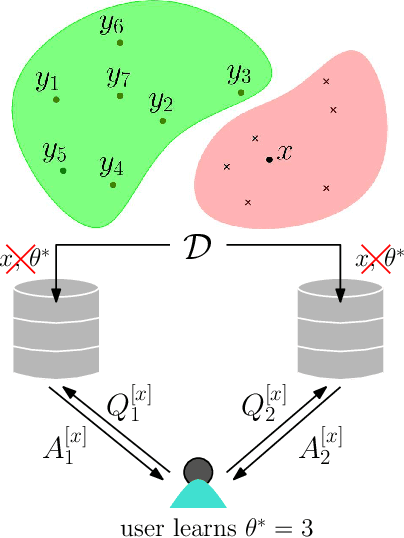

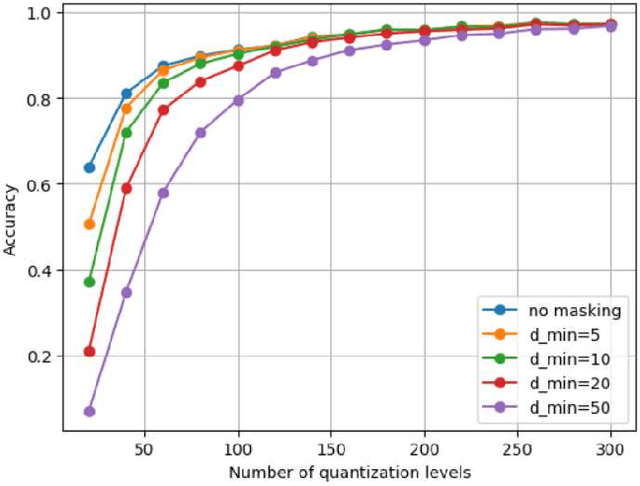
Abstract:Transparency and explainability are two extremely important aspects to be considered when employing black-box machine learning models in high-stake applications. Providing counterfactual explanations is one way of catering this requirement. However, this also poses a threat to the privacy of both the institution that is providing the explanation as well as the user who is requesting it. In this work, we propose multiple schemes inspired by private information retrieval (PIR) techniques which ensure the \emph{user's privacy} when retrieving counterfactual explanations. We present a scheme which retrieves the \emph{exact} nearest neighbor counterfactual explanation from a database of accepted points while achieving perfect (information-theoretic) privacy for the user. While the scheme achieves perfect privacy for the user, some leakage on the database is inevitable which we quantify using a mutual information based metric. Furthermore, we propose strategies to reduce this leakage to achieve an advanced degree of database privacy. We extend these schemes to incorporate user's preference on transforming their attributes, so that a more actionable explanation can be received. Since our schemes rely on finite field arithmetic, we empirically validate our schemes on real datasets to understand the trade-off between the accuracy and the finite field sizes.
Quantifying Prediction Consistency Under Model Multiplicity in Tabular LLMs
Jul 04, 2024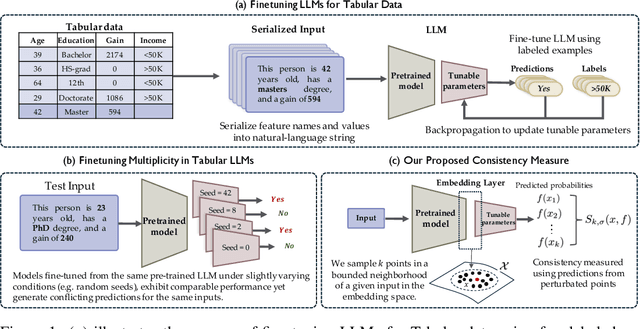
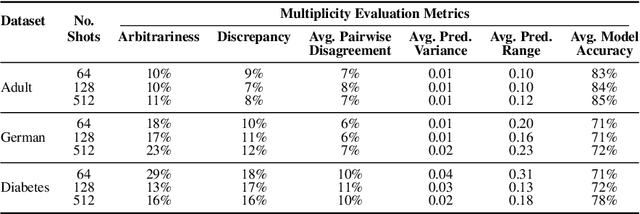


Abstract:Fine-tuning large language models (LLMs) on limited tabular data for classification tasks can lead to \textit{fine-tuning multiplicity}, where equally well-performing models make conflicting predictions on the same inputs due to variations in the training process (i.e., seed, random weight initialization, retraining on additional or deleted samples). This raises critical concerns about the robustness and reliability of Tabular LLMs, particularly when deployed for high-stakes decision-making, such as finance, hiring, education, healthcare, etc. This work formalizes the challenge of fine-tuning multiplicity in Tabular LLMs and proposes a novel metric to quantify the robustness of individual predictions without expensive model retraining. Our metric quantifies a prediction's stability by analyzing (sampling) the model's local behavior around the input in the embedding space. Interestingly, we show that sampling in the local neighborhood can be leveraged to provide probabilistic robustness guarantees against a broad class of fine-tuned models. By leveraging Bernstein's Inequality, we show that predictions with sufficiently high robustness (as defined by our measure) will remain consistent with high probability. We also provide empirical evaluation on real-world datasets to support our theoretical results. Our work highlights the importance of addressing fine-tuning instabilities to enable trustworthy deployment of LLMs in high-stakes and safety-critical applications.
Quantifying Spuriousness of Biased Datasets Using Partial Information Decomposition
Jun 29, 2024Abstract:Spurious patterns refer to a mathematical association between two or more variables in a dataset that are not causally related. However, this notion of spuriousness, which is usually introduced due to sampling biases in the dataset, has classically lacked a formal definition. To address this gap, this work presents the first information-theoretic formalization of spuriousness in a dataset (given a split of spurious and core features) using a mathematical framework called Partial Information Decomposition (PID). Specifically, we disentangle the joint information content that the spurious and core features share about another target variable (e.g., the prediction label) into distinct components, namely unique, redundant, and synergistic information. We propose the use of unique information, with roots in Blackwell Sufficiency, as a novel metric to formally quantify dataset spuriousness and derive its desirable properties. We empirically demonstrate how higher unique information in the spurious features in a dataset could lead a model into choosing the spurious features over the core features for inference, often having low worst-group-accuracy. We also propose a novel autoencoder-based estimator for computing unique information that is able to handle high-dimensional image data. Finally, we also show how this unique information in the spurious feature is reduced across several dataset-based spurious-pattern-mitigation techniques such as data reweighting and varying levels of background mixing, demonstrating a novel tradeoff between unique information (spuriousness) and worst-group-accuracy.
Model Reconstruction Using Counterfactual Explanations: Mitigating the Decision Boundary Shift
May 08, 2024Abstract:Counterfactual explanations find ways of achieving a favorable model outcome with minimum input perturbation. However, counterfactual explanations can also be exploited to steal the model by strategically training a surrogate model to give similar predictions as the original (target) model. In this work, we investigate model extraction by specifically leveraging the fact that the counterfactual explanations also lie quite close to the decision boundary. We propose a novel strategy for model extraction that we call Counterfactual Clamping Attack (CCA) which trains a surrogate model using a unique loss function that treats counterfactuals differently than ordinary instances. Our approach also alleviates the related problem of decision boundary shift that arises in existing model extraction attacks which treat counterfactuals as ordinary instances. We also derive novel mathematical relationships between the error in model approximation and the number of queries using polytope theory. Experimental results demonstrate that our strategy provides improved fidelity between the target and surrogate model predictions on several real world datasets.
Distribution of the Scaled Condition Number of Single-spiked Complex Wishart Matrices
May 11, 2021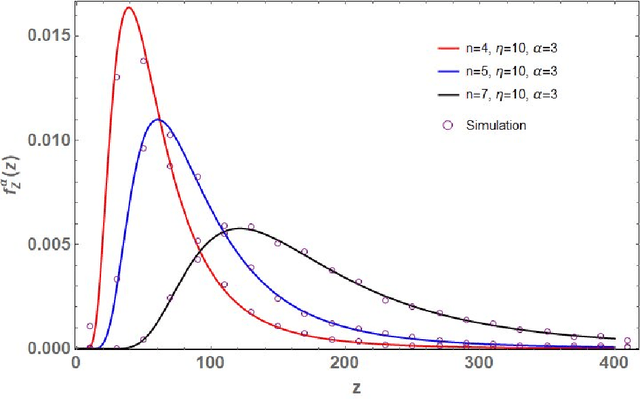
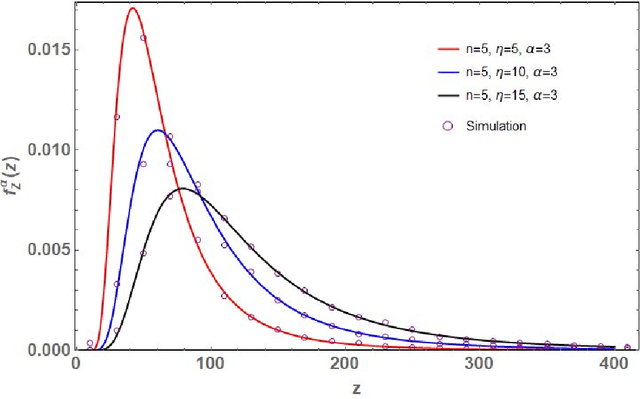
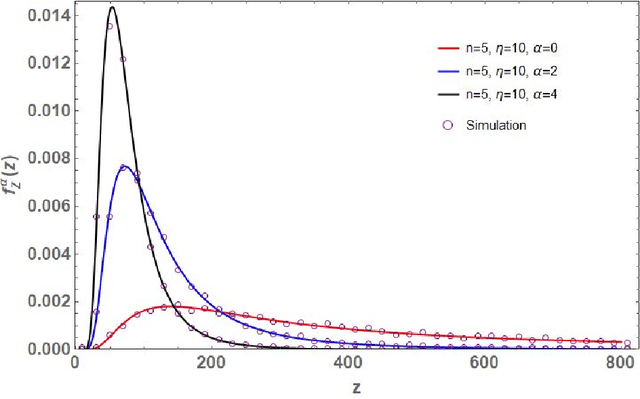
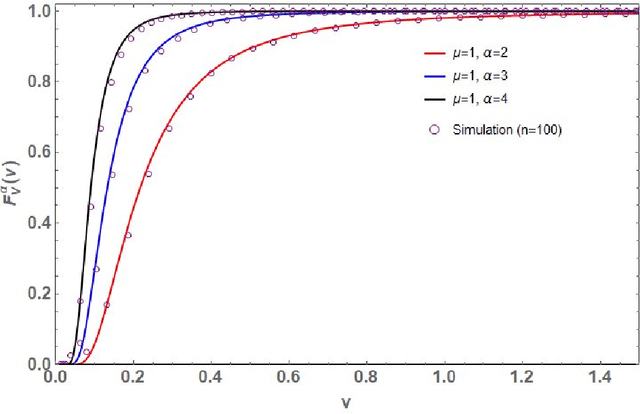
Abstract:Let $\mathbf{X}\in\mathbb{C}^{m\times n}$ ($m\geq n$) be a random matrix with independent rows each distributed as complex multivariate Gaussian with zero mean and {\it single-spiked} covariance matrix $\mathbf{I}_n+ \eta \mathbf{u}\mathbf{u}^*$, where $\mathbf{I}_n$ is the $n\times n$ identity matrix, $\mathbf{u}\in\mathbb{C}^{n\times n}$ is an arbitrary vector with a unit Euclidean norm, $\eta\geq 0$ is a non-random parameter, and $(\cdot)^*$ represents conjugate-transpose. This paper investigates the distribution of the random quantity $\kappa_{\text{SC}}^2(\mathbf{X})=\sum_{k=1}^n \lambda_k/\lambda_1$, where $0<\lambda_1<\lambda_2<\ldots<\lambda_n<\infty$ are the ordered eigenvalues of $\mathbf{X}^*\mathbf{X}$ (i.e., single-spiked Wishart matrix). This random quantity is intimately related to the so called {\it scaled condition number} or the Demmel condition number (i.e., $\kappa_{\text{SC}}(\mathbf{X})$) and the minimum eigenvalue of the fixed trace Wishart-Laguerre ensemble (i.e., $\kappa_{\text{SC}}^{-2}(\mathbf{X})$). In particular, we use an orthogonal polynomial approach to derive an exact expression for the probability density function of $\kappa_{\text{SC}}^2(\mathbf{X})$ which is amenable to asymptotic analysis as matrix dimensions grow large. Our asymptotic results reveal that, as $m,n\to\infty$ such that $m-n$ is fixed and when $\eta$ scales on the order of $1/n$, $\kappa_{\text{SC}}^2(\mathbf{X})$ scales on the order of $n^3$. In this respect we establish simple closed-form expressions for the limiting distributions.
 Add to Chrome
Add to Chrome Add to Firefox
Add to Firefox Add to Edge
Add to Edge